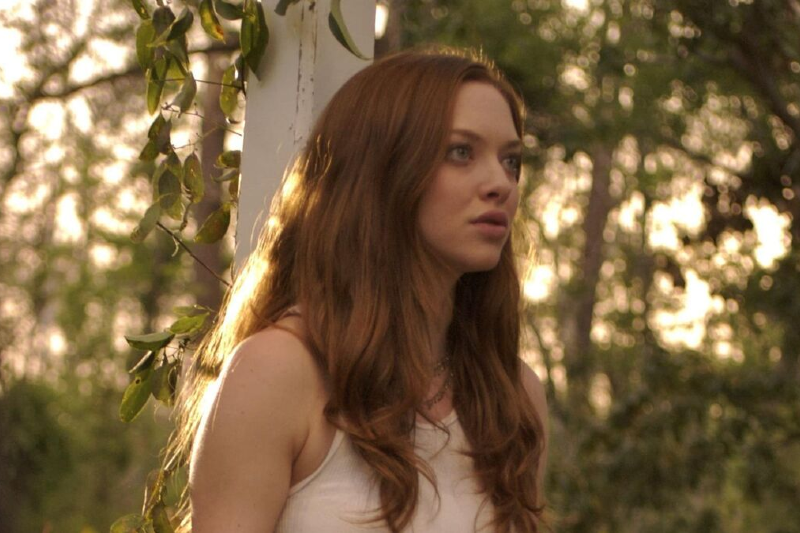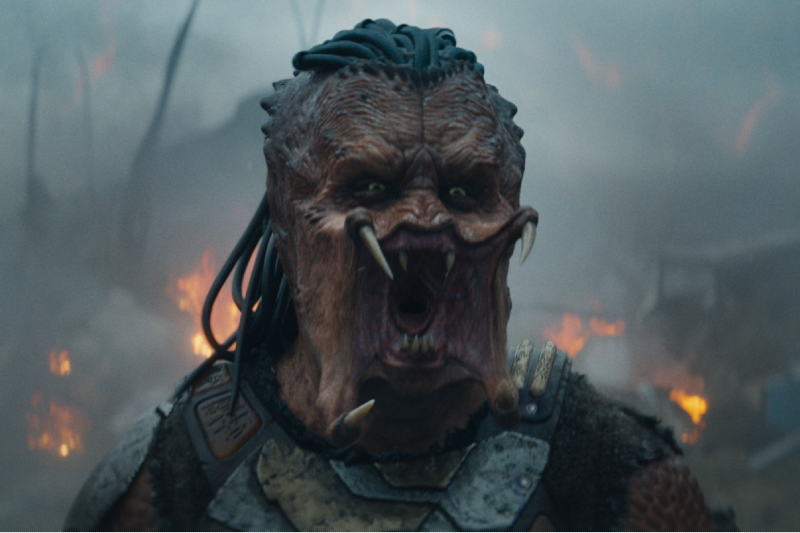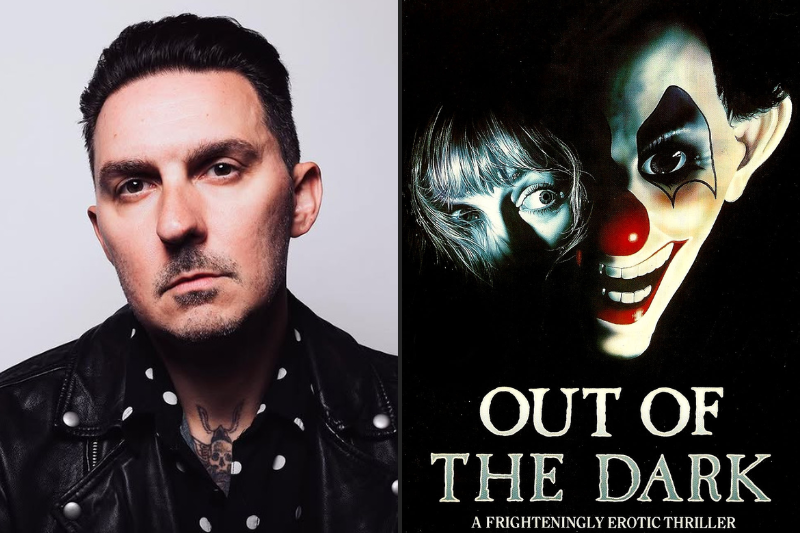Looking back at the Uterus Horror films we’ve covered over the years, many prominently feature a young woman going through a monstrous transformation. Some notable ones are Ginger Snaps, When Animals Dream, and Blue My Mind. In 2018, director Fritz Böhm made his feature-film debut with Wildling, a film he also co-wrote with Florian Eder. The film follows a teenage girl who has been raised in isolation by her protective father. After being freed and placed in the care of the town sheriff, the teenager quickly discovers everything she thought she knew about the world, and herself, was a lie.
When the audience first meets Anna (Bel Powley) and the man she knows as “Daddy” (Brad Dourif), he’s telling her the story of the wildlings. Daddy claims the wildlings are vicious beasts lurking in the woods who ate all the other children. Taught to fear the outside world, Anna is kept in the attic, never even allowed to go downstairs. When Anna gets her first period, Daddy claims she’s sick. He begins giving her daily injections to help fight her “illness,” injections that are quite painful and make Anna more and more sick over the years.
Now a teenager, Anna is forced to finally engage with the world after Daddy attempts to kill himself and the sheriff discovers them. Sheriff Ellen Cooper (Liv Tyler) tells Anna that her father survived the gunshot, but he’s in critical condition and must remain in the hospital. With no known family, Anna goes to stay with Ellen and her teenage brother, Ray (Collin Kelly-Sordelet).
This is the beginning of Anna’s mental and physical transformation. Much of the physical changes are due to Anna no longer getting the injections for her supposed illness. This injection, it turns out, is a hormone treatment that effectively stopped Anna from going through puberty. When she gets her period after leaving the hospital, it’s only the second time she’s bled since she was a pre-teen. This is just the beginning of Anna’s physical changes. Her teeth begin to fall out, only to be replaced by sharp fangs. The nails on her hands and feet become claws. Fur starts growing all over her body. Anna is a wildling, and she eventually completely transforms into a creature similar to a werewolf. However, like the other examples of physical transformations in Uterus Horror mentioned above, this is a permanent change, just like real puberty.
Anna’s emotional transformation is just as dramatic as her physical one. Her entire life, she’s been taught by Daddy to fear wildlings, the very thing she is. It makes her a very fearful young woman, afraid of all the new things she’s experiencing, as well as the ever-present threat of the wildlings. This fear is so deeply ingrained that when a school bully attempts to sexually assault Anna, her mind interprets it as a wildling attack. That is until Anna fights back, ripping her attacker's throat out. This is the first major turning point for Anna. She not only realizes she’s a wildling, but she also finally understands her own power. The man who raised her, who is not her real father, taught Anna to fear the very thing she truly is. Now Anna understands she shouldn’t fear men, but they should fear her. Understanding and accepting her true nature helps Annablossom into a strong, confident, fierce wildling woman.
As Anna is discovering her true nature, she also experiences first love. Ray is the only man, teen or otherwise, who treats Anna well. They’re both outsiders in their own ways, which brings them together. While their love story is one of the more underdeveloped aspects of the plot, and takes a backseat to Anna’s wildling transformation, it still fits into the expected story elements commonly found in Uterus Horror films. In fact, Wildling takes the love story a step past Uterus Horror and moves into Pregnancy Horror, showing Anna at the climax of the film fully transformed and fighting for her life in the wilderness while heavily pregnant.
Wildling is a compelling story of self-discovery, but there are moments when it’s clear this story of a girl becoming a woman was written by men. Many of the “important” life lessons Ellen teaches Anna on her road to womanhood are things like how to properly shave your legs and how to use tampons, the latter being an odd choice for a sheltered teenager only experiencing the second menstrual cycle of her entire life. These moments very much feel like a man’s interpretation of what it means to be a woman.
At the same time, the storyline between Anna and Daddy is a fascinating look at strong women just trying to exist in a patriarchy. We learn that Daddy, along with other hunters, killed all the wildlings when Anna was just a baby. This includes Anna’s mother. Yet when Daddy found baby Anna, he couldn’t bring himself to kill her, too. Instead, he hid her away in his attic and raised her as a human child.
What sounds like an act of mercy was really an act of control. In fact, every action taken by Daddy and the hunters could be interpreted as men trying to control uncontrollable women. The only wildlings we know of are Anna and her mother. This could mean all wildlings are female (we know humans and wildlings can mate so perhaps that’s how they reproduce in a predominantly female population). Daddy and the hunters killed the wildlings because they were wild and free in a way the human men couldn’t understand or control.
Daddy thought he could control Anna by raising her as his own, but her own biology proved too powerful. He gave Anna the injections to keep her from going through puberty and stave off her wilding nature, even though those injections made her deathly ill. When Anna was on death’s door from the medication, and Daddy couldn’t control the situation anymore, he decided to let her die and kill himself. But don’t be fooled, as his suicidal ideations were not out of love or remorse. This becomes clear when Daddy first sees Anna again after she’s free from his rule and knows the truth. She’s no longer his little human girl blinded by his lies. She’s a wildling, and Daddy only wants to kill wildlings. The man who raised her, who can no longer control her, rounds up the hunters to kill Anna. Daddy even tries to cut Anna’s baby from her belly, showing no regard for the woman he raised, planning to start the cycle all over again with this baby. Luckily, Anna has fully embraced her true nature and kills Daddy before he can kill her and take the baby, symbolically killing her past at the same time.
Despite the moments in Wildling that clearly show a male perspective, there is still a fascinating Uterus Horror story being told here. Anna experiences years of life and growth in a short amount of time. She falls in love, goes through puberty, realizes she’s a wildling, gets pregnant, and fully transforms in a matter of months, but it’s the battle against the patriarchy’s rule that makes this film stand out. Wildling women are wild and capable – they don’t need men to protect them, provide for them, or control them. It’s no wonder the small-minded men in this small-town fear and hate the wildlings, just as the weak-minded always fear and hate what they can’t understand or control. Anna is the embodiment of feminism, and Daddy is the embodiment of the patriarchy. It makes Anna’s journey, transformation, and triumph over Daddy all the more satisfying.
About this series: in a genre typically considered “for the guys,” it’s time to give a nod to the ladies. Uterus Horror is a subgenre of horror films that focuses on the uniquely female experience of puberty and the act of coming into your sexuality, using horror elements to emphasize and/or act as a metaphor for that experience. These films are often ignored in theaters but quickly develop cult followings. Columnist Molly Henery, who named and defined the subgenre, tackles a new film each month and analyzes how it fits into this bloody new corner of horror.






